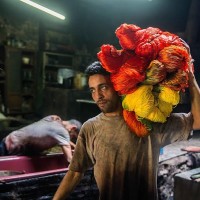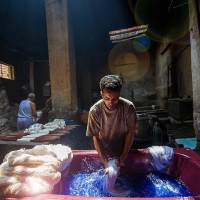The long process of transforming original white fabric into the final product—the clothes we wear everyday—rarely crosses our minds. The fancy and unique designs, lace fabrics, and colourful cloths that form our day-to-day fashion all originated as white textiles.
In one of the oldest dying factories, located in Old Cairo, yarn is still put through a man-made dyeing process. Mohammed Moustafa, 53, spends every day colouring different fabrics with several shades and hues, the first process of creating any piece of clothing.
“I’ve been dyeing yarn for 14 years now, and no one believes that I am extremely happy and satisfied with my job,” said Moustafa.
Believing that he plays a central role in supporting people’s happiness when they wear something they are excited about, Moustafa finds his job as effective as anyone else’s. “I dye every type of cloth, starting from ordinary cotton fabrics, and sometimes fancy, extremely expensive lace fibres, and I know for sure that my output is better than that of factories,” he said.
Through his daily routine, Moustafa faces many dangers in order to come out with the final product. He risks severe burns because he has to put the white fabric into hot, almost boiling, coloured water.
“In order to have a strong colour, the fabric has to be placed in hot water with the desired colour and some salt in order to stabilise the colour. We face the risk of getting burned everyday while dyeing dozens of fabrics,” said Moustafa.
After that, he presses them tightly together, sometimes with his bare hands, while they are still hot and then puts them up to dry.
Amid the increasing import of fabrics from China and elsewhere due to cheaper prices, Moustafa’s job is at risk. “People have stopped buying our products, despite the fact that our products are better.”
Moustafa said he is confident that his job will never go extinct, but he wishes people would continue buying his products like they used to.
Photographed by Mohammed Omar















